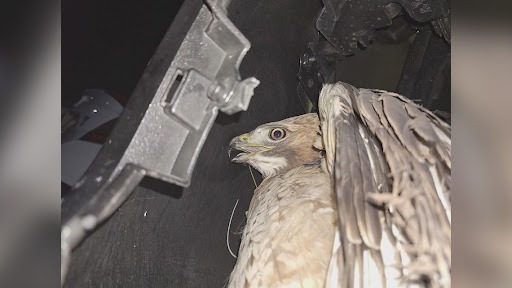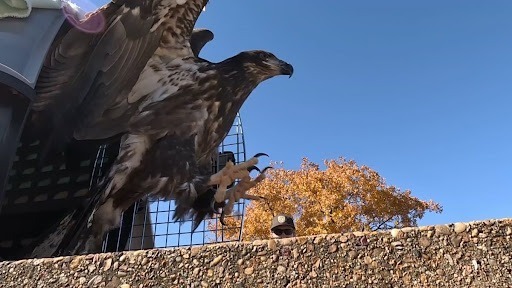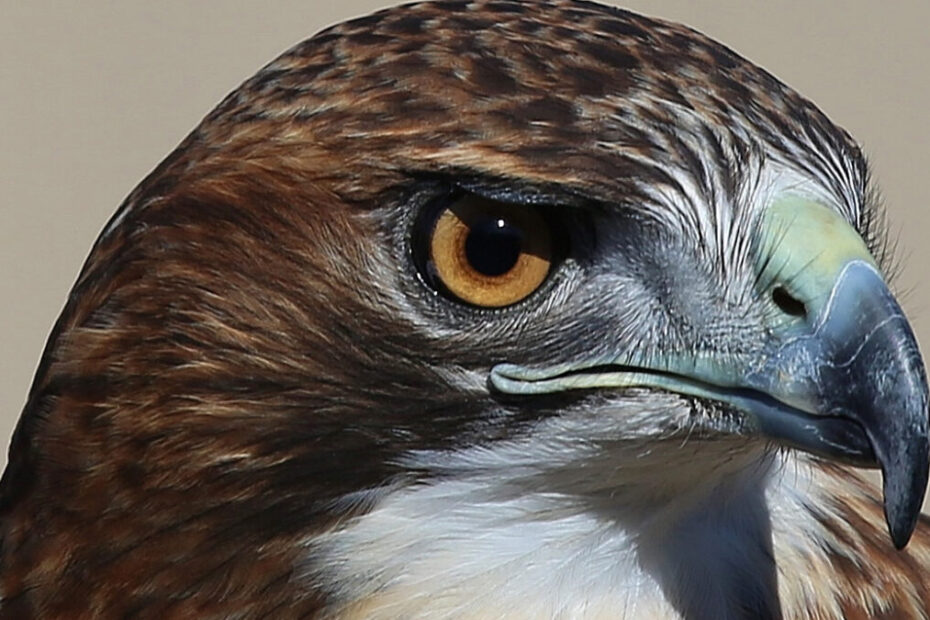Hawk that was hit by a vehicle in Texas was released back into the wild
Click here to watch the story!
More results...
Click here to watch the story!
Click here to watch the story!
Get all the news, events, and updates on the raptors in our eNewsletter delivered to your email box monthly.
Healthy prairie acts as a carbon sink. The plants, during photosynthesis, take in atmospheric carbon. Some of this carbon is deposited into the soil via the roots. Soil carbon decomposes more slowly and is thus kept out of the atmosphere for longer. At a global level, soil stores ~2,000 billion tons of carbon at any given time.
Healthy prairie regulates the supply of water. As the water is absorbed into the soil, it does not travel on the surface which eliminates erosion and prevents waterways from becoming silted. Because the water is traveling through the soil and across the roots of plants, it is slowed down and reaches the streams/creeks/rivers at a more moderate, consistent flow rate. This helps to prevent flashiness, which leads to flooding and erosion along the waterways. Major benefits to Lake Lavon as prairies are helping to prevent silting of the lake, and helping to prevent flooding.
Healthy prairie regulates water quality. Rainwater and water from surrounding impervious surfaces are absorbed into the soil. It then flows through the soil horizons, along the roots of the plants both of which act as a filter. The soil and plant roots together help to remove impurities that come from roadways, roadsides, and residential areas. This is very important as it helps to improve the quality of the water in Lake Lavon.
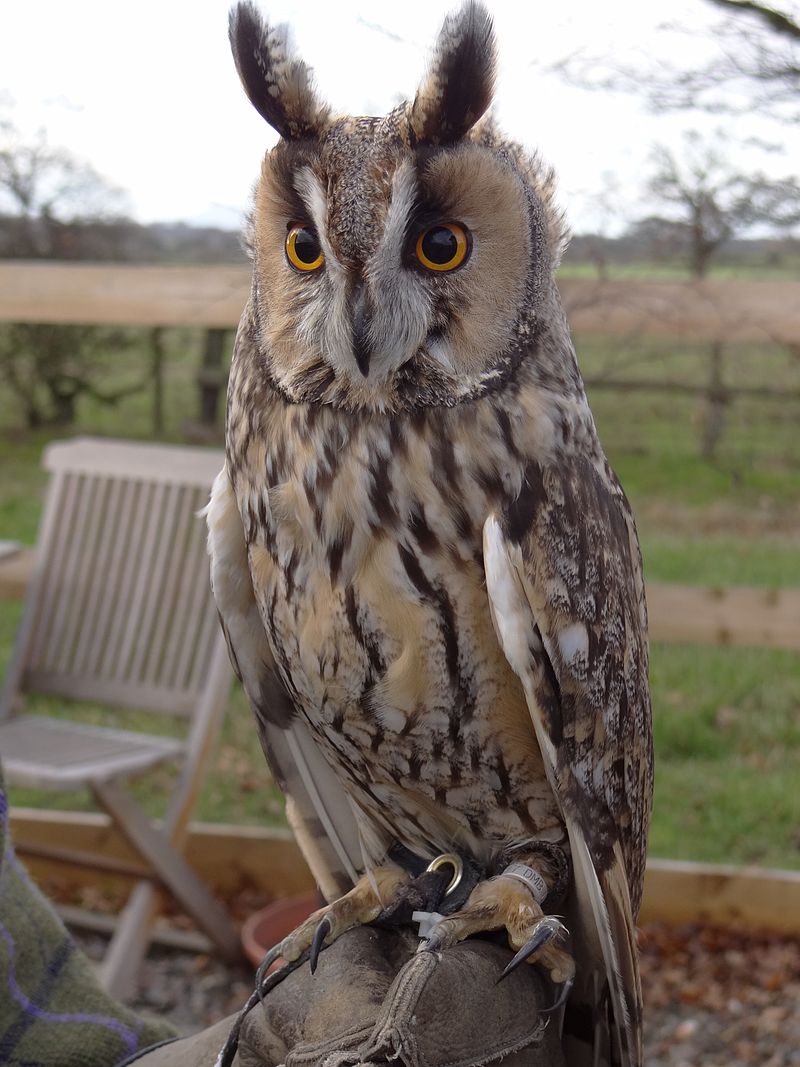
Normally found in the western states, on occasion they can be found in north Texas in small colonies. They have long ear tufts giving them their name (though the tufts are not their ears). Bright eyes look like they are always surprised.
Length: 14”
Wingspan: 35” to 40”
Weight: 8 to 15 ounces
Plumage: Dark bird with intricate black, brown and buff patterns. Ear tufts very long.
Habitat: Wood areas.
Flight: Back and forth very low to the ground.
Vocalization: Very low, soft hoots and cat-like meows.
Food: Small rodents.
Nesting: Stick nests borrowed from other birds. Usually 2 – 10 eggs hatch in about 30 days. Leave nest in 5 weeks and parents will help feed young for at least 10 to 11 weeks.

The Barred Owl is a permanent resident of north Texas. In the fall and winter they become much more vocal which makes them easy to locate and identify.
Length: 21”
Wingspan: 42”
Weight: 1.4 – 2.0 lbs
Plumage: Adults have vertical dark brown bars on their chest. Wings and tail are mottled brown and white. The face is quite distinguishing with a large facial dish and black eyes.
Habitat: Found in wooded areas.
Flight: Perch and pounce hunters. Strong, consistent wing beats and the head facing forward looks flat. A very stocky-looking bird.
Vocalization: Loud “Who cooks for you, who cooks for you-aalllllll’ with the last note descending in tone. Two or three may hoot at the same time with various barking-like sounds as well as the call.
Food: Rodents, amphibians, even crayfish.
Nesting: Found in the cavities of trees. Occasionally they will use nest boxes 20 ft. up. They usually lay 2-3 eggs that are incubated for about 30 days. Young fledge in about 6 weeks.

The largest owl (by weight) in North America. When food is scarce during winter in Canada, Snowy Owls will fly south looking for food. This is known as an ‘irruption’ and many will be found far south of their usual hunting grounds.
Length: 27”
Wingspan: 4.5 to 5.5 feet
Weight: 3.5 to 4.5 pounds lbs
Plumage: Mostly white with some dark bars.
Habitat: Tundra, an airport field or beach dunes. They prefer rolling terrain so they can view their territory.
Flight: Snowy owls sit for many hours at a time. Diving flight going after food.
Vocalization: Low, raspy hoots. Hissing in defense.
Food: Lemmings or waterfowl.
Nesting: Nests on the ground Usually 3 – 11 eggs that hatch in about 32 days. Leave nest in 5 weeks but takes about 10 weeks before flying well. Parents will help feed young for at least 9 to 10 weeks.
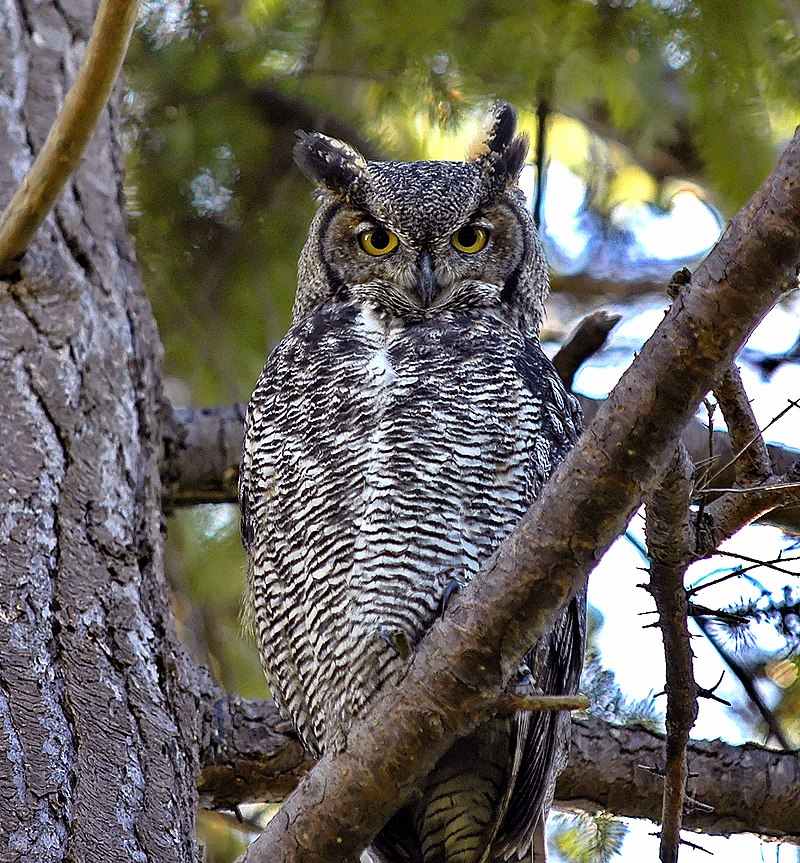
The Great Horned Owl is a permanent resident of North Texas. In the fall and winter they become much more vocal which makes them easy to locate and identify. Our largest owl in the area with distinct feather tufts on the head. Known as the ‘Hoot” owl.
Length: 23”
Wingspan: 45”
Weight: 3 – 4 lbs
Plumage: Chest is brown with black horizontal bars. Wings and tail can be brown to gray with black bars. Distinct discs around yellow eyes. Feather tufts on top of head.
Habitat: Found in wooded areas. In the evening can be seen perched on large branches preparing to hunt.
Flight: Perch and pounce hunters. Strong, consistent wing beats and the head facing forward looks flat.
Vocalization: A soft ‘who who-who who whooo’. Female voice is usually higher than male.
Food: Mammals up to rabbit and skunk.
Nesting: Usually uses old nests from Red-tailed hawks. Will nest in tree cavity or on rock ledge. Breeds in January here in Texas. Usually 2 – 3 eggs that hatch in about 32 days. Leave nest in 5 weeks but takes about 10 weeks before flying well. Will stay with adults for many months after learning to fly. There are 4 – 6 eggs that hatch in about 35 days. Young fledge in about 40 days.
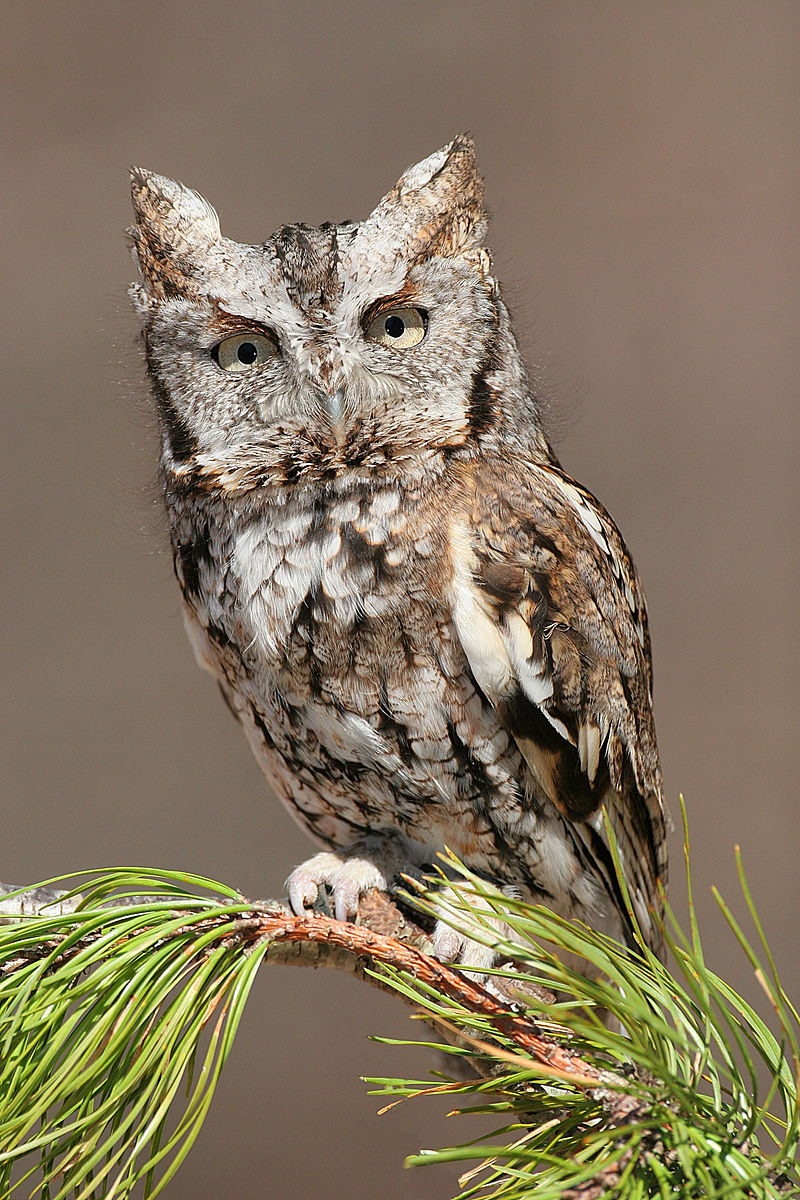
The Eastern Screech Owl is a permanent resident of north Texas. They are the most common owl found in north Texas. There are a number of color morphs in Screech Owls ranging from red to gray. Depending upon the area of the country, the ratio of color changes. In Texas, the majority are gray, in the eastern United States the majority are red.
Length: 8”
Wingspan: 20”
Weight: 4 – 6 oz.
Plumage: Range of colors from gray to red. Many colors in between can be found that are considered ‘brown phase’. Very streaked all over with distinct yellow eyes. They have feather tufts, used for camouflage, on top of their head. Nestlings are downy gray.
Habitat: Found in wooded areas.
Flight: Perch and pounce hunters. Very quick and quiet in flight and rarely seen.
Vocalization: Two distinct calls that are very soft. The first is a long trill on the same note. This call is usually a communication between Screech Owls. The second is a descending whinny that sounds like a horse whinny. This call usually means the bird is irritated in some way, by an intruder in its territory or even a human coming too close.
Food: Favorite food is large cockroaches, will eat mice also.
Nesting: Found in the cavities of trees. Occasionally they will use nest boxes 15 ft. up. They usually lay 4-5 eggs that are incubated for about 26 days. Young fledge in about 4 weeks but remain dependent on parents for another 8 weeks.
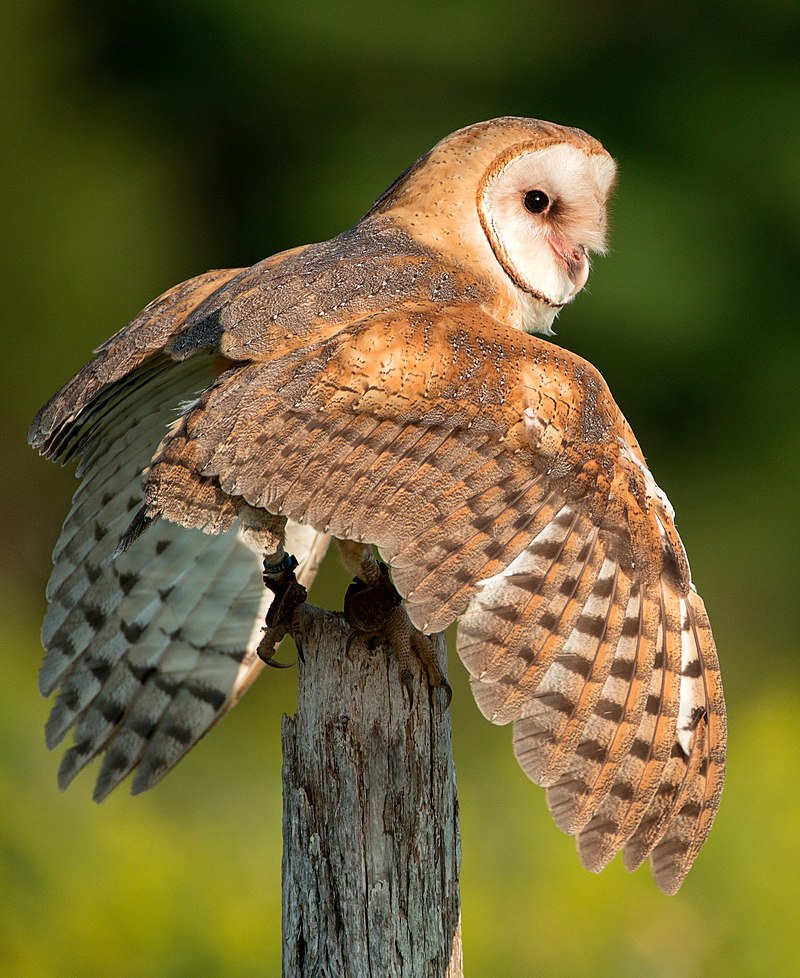
The Barn Owl is a permanent resident of north Texas. It can be found on every continent except Antarctica. Barn owls are considered to have the best hearing of any animal ever tested and are able to hunt in complete darkness. For defense they will “toe dust”, leaning their head down to their toes and swaying it back and forth while hissing.
Length: 13 – 15”
Wingspan: 40 -49”
Weight: 1 lb
Plumage: Mostly white on the chest with some spots. The back is a gold color, mottled with gray and black. The white face is distinctly heart-shaped with black eyes. It has long legs with white feathers.
Habitat: Found in open areas with woods or buildings nearby for nesting. These owls will use a nest box.
Flight: Perch and pounce hunters with long, slender wings. From underneath they will look all white.
Vocalization: Loud hissing scream used in defense.
Food: Small rodents, mainly voles and mice. They will eat up to 4 a night due to their high metabolism.
Nesting: Found in cavities of trees. They will use nest boxes 20 ft. up or empty buildings. The nests normally don’t have nesting materials, just whatever is already there. Usually lay 3-11 eggs that are incubated for about 34 days. Young fledge in about 60 days.
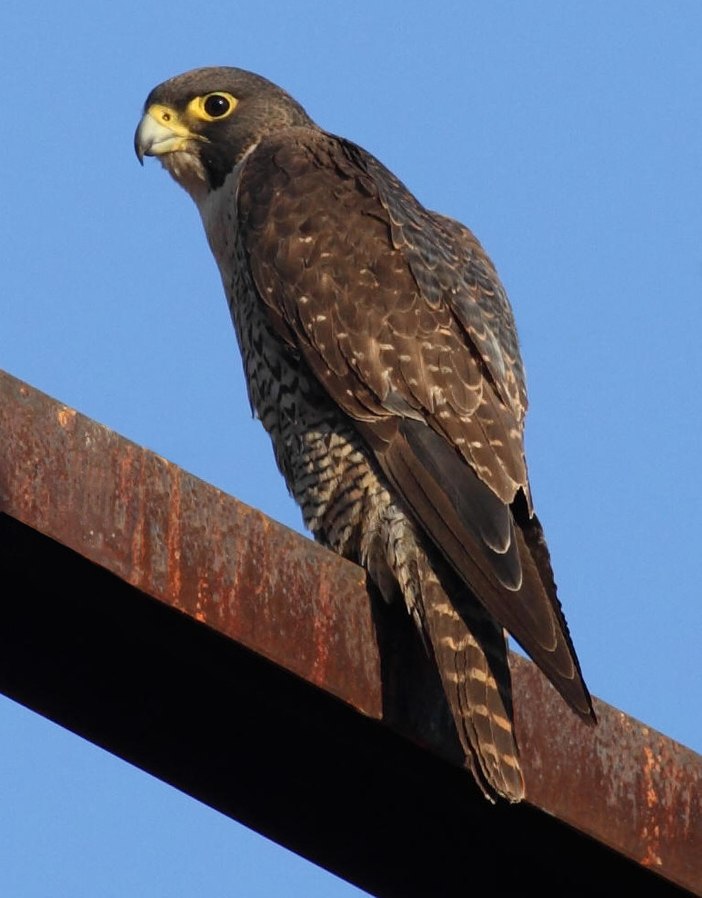
The Peregrine Falcon is an uncommon sighting in North Texas, but has been seen in all seasons. It can be found in open areas. There are a number of subspecies but most commonly anatum has been sighted with occasional tundrius seen in migration.
Length: 16 – 20”
Wingspan: 42”
Weight: M 1.2 lb F 1.5 – 2 lb.
Plumage: Slate-colored head and back. Tail is dark gray with light gray bands. Chest is light tan with bars across. Head has large dark ‘helmet’ look.
Habitat: Open areas.
Flight: Strong, consistent wing beats. This bird flies fast and straight, looks very powerful. Pointed wings.
Vocalization: A loud, fast krek-krek-krek-krek.
Food: Duck and other medium-size game.
Nesting: Not normally found nesting in North Texas. Nests on cliff faces and ledges of tall buildings. They usually lay 3-4 eggs that are incubated for about 29 days. Young fledge in about 5 weeks but are dependant on parents for 2 more months.
Note: Peregrine Falcons have been clocked doing over 230 miles per hour when diving (known as a stoop) on their prey.
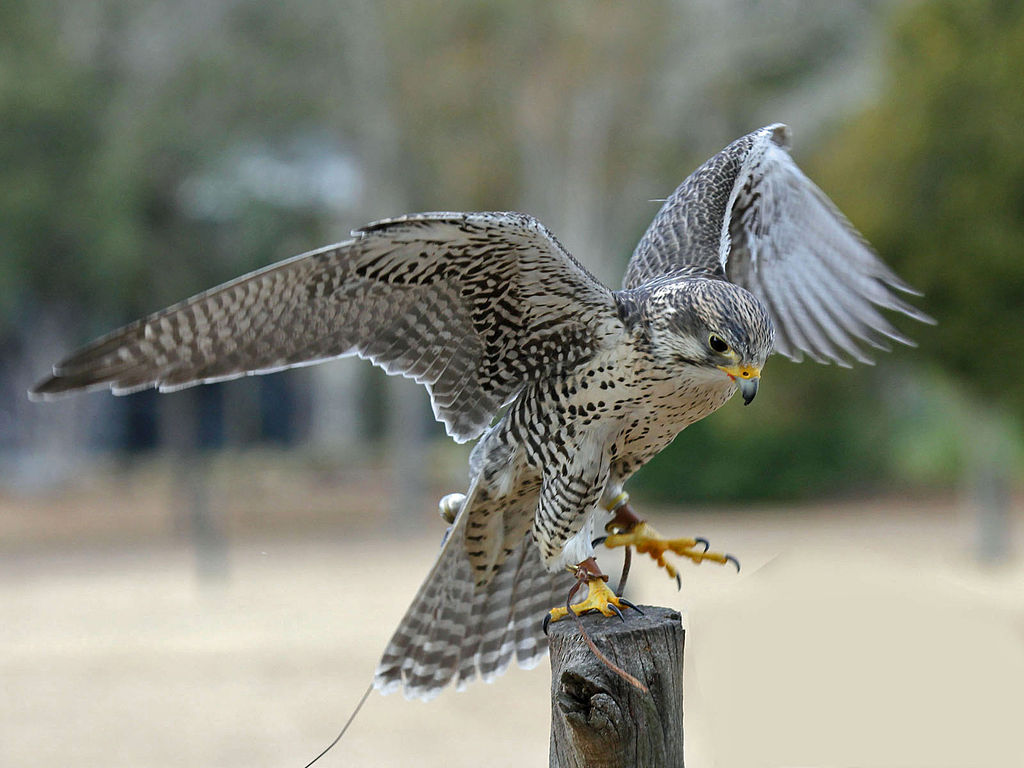
The Prairie Falcon is a rare visitor to North Texas and has been seen in winter and spring. Towards Wichita Falls they become a little more common. It can be found in open areas.
Length: 15 – 19”
Wingspan: 40”
Weight: Male: 1.2 lb; Female: 1.5 – 2.0 lb
Plumage: Pale brown on head, back, tail and wings. White chest with brown spots. When flying, it has distinct black coverts and axillaries (or armpit feathers) where the wings meet the body.
Habitat: Open areas.
Flight: Strong, consistent wing beats. This bird flies fast and straight, looks very powerful. Wings are not as pointed as the Peregrine Falcon.
Vocalization: A loud, fast kree-kree-kree-kree. Similar to Peregrine Falcon.
Food: Birds and small mammals.
Nesting: Not normally found nesting in North Texas. Nests on cliff faces and rock outcrops. They usually lay 4 – 5 eggs that are incubated for about 29 days. Young fledge in about 6 weeks.

The American Kestrel is a year-round resident in Texas and is common throughout the United States. It is the smallest falcon in North America. It can be found in open areas usually sitting on a powerline overlooking a field. A common habit is bobbing its head and ‘wagging’ its tail up and down while perched. This is the only raptor than can be identified as male or female based on plumage.
Length: 9”
Wingspan: 23”
Weight: Male: 85 – 100g (3 oz); Female: 110 – 125g (4 oz)
Plumage: Difference between male and female. Male has gray-blue on wings and on much of the head, tail is solid rust-red with black band at tip. Female has rust-red wings and tail with black bars. Usually a little bit of gray-blue on head. Both have spots on chest though male usually has light rust color overall on upper half.
Habitat: Found in open areas overlooking fields. Common on power lines looking for prey in fields.
Flight: Strong wing beats, but does not usually fly straight and powerful like larger falcons. Will ‘kite’ (hover) over fields when hunting.
Vocalization: A loud, fast killy-killy-killy.
Food: Small birds and mammals.
Nesting: Found in areas with scattered trees or edge of woodlands. Cavity nesters, will use nest boxes. No material is added to nest, using what ever is already present. They usually lay 4-5 eggs that are incubated for about 30 days. Young fledge in about 5 weeks.
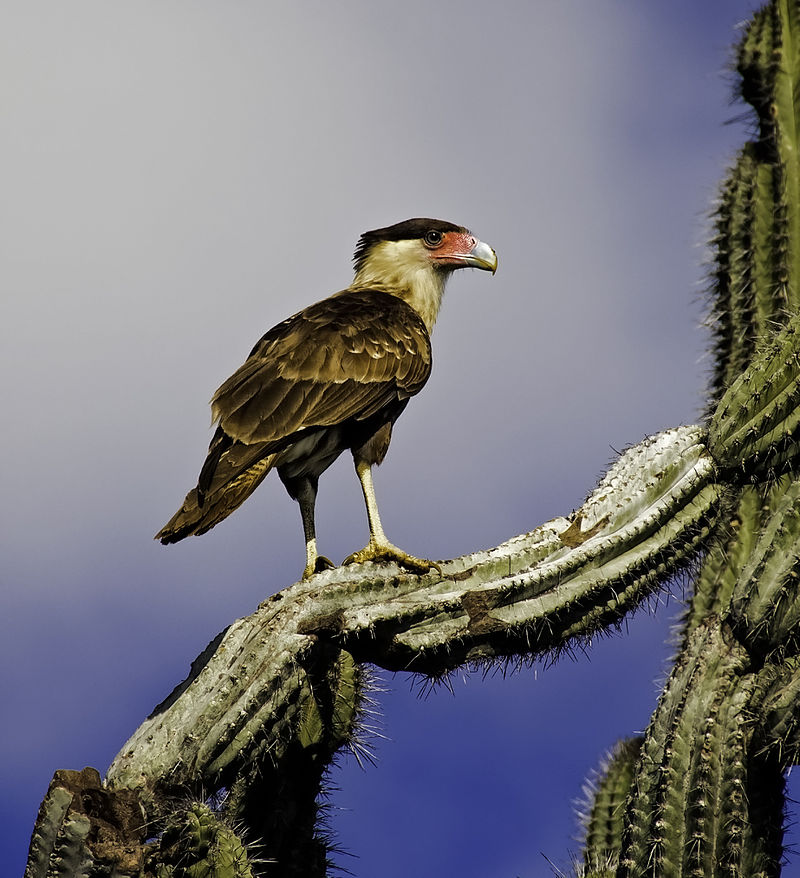
The Caracara is an uncommon bird in north Texas and has a very unique look. Previously known as Crested Caracara.
Length: 24”
Wingspan: 50”
Weight: 2.25 lbs
Description: Distinctive bird. Wings are black with white tips. Head has a black crest, red face and white neck. Belly is black, tail is speckled white with broad black band at tips.
Habitat: Found in open grasslands usually on the ground.
Flight: Long steady wingbeats.
Vocalization: Normally silent, but has a croaking call.
Food: Mainly carrion.
Nesting: Found in trees or rock ledges, Site will be re-used every year with additional material being added. Usually 2-3 eggs that hatch in about 28 days. Leaves nest in 6 – 7 weeks but remains nearby for many weeks.
Notes: Seen South and East of Dallas, known nesting sites near Greenville.
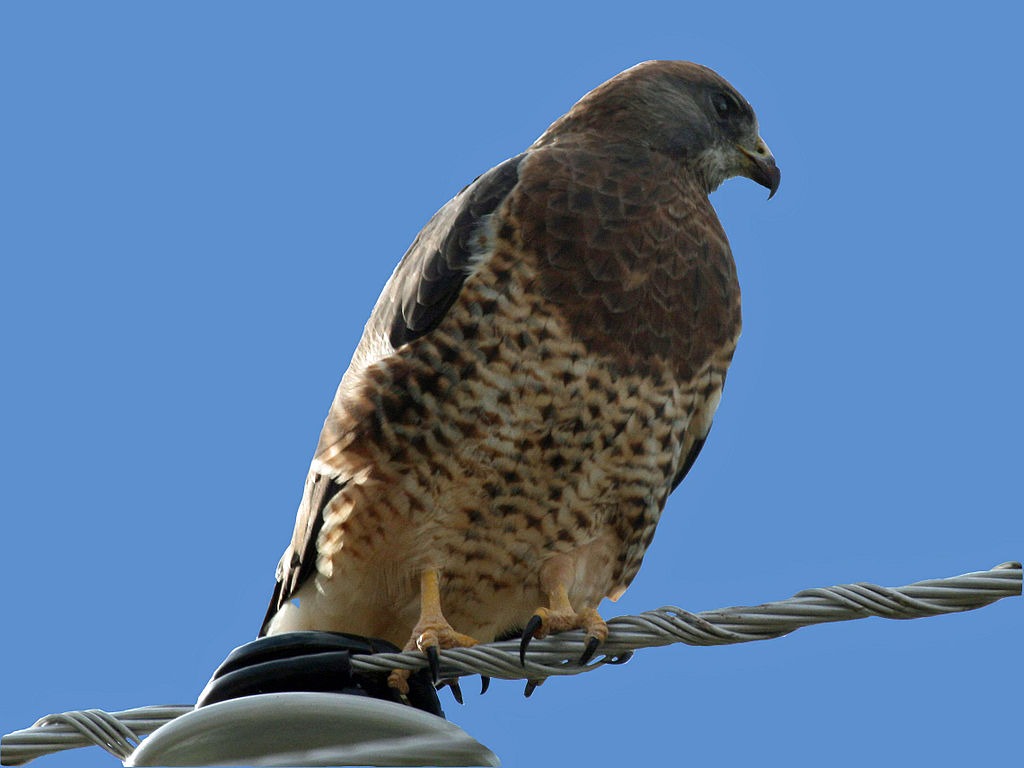
The Swainson’s Hawk is a migrant in Texas and western North America. Some take up residence in Texas during the summer, especially west Texas. These birds migrate to Argentina in the winter. Each year they may fly over 6,000 miles. In the fall, they can be seen in groups of hundreds to thousands soaring overhead. They have been seen sitting on fence lines by the hundreds in the morning before taking off to head south.
Length: 19”
Wingspan: 48 – 52”
Weight: 2 lbs
Plumage: Adults have a dark head that looks like a helmet and a very dark brown back, The upper chest is dark brown while the rest is very light. In flight, the trailing edges of the wings are very dark. Immature are dark mottled overall with a light chest.
Habitat: Found in grasslands with woods nearby.
Flight: Similar to Red-tailed Hawks. Combination of flapping and soaring. Usually seen soaring over fields. Will kite over fields looking for prey.
Vocalization: Similar to Red-tailed Hawk scream, but higher and weaker.
Food: Small mammals and insects in fields.
Nesting: Found in trees next to fields. Made of sticks and grasses. They usually lay 2 eggs that are incubated for about 28 days. Young fledge in about 5 weeks.
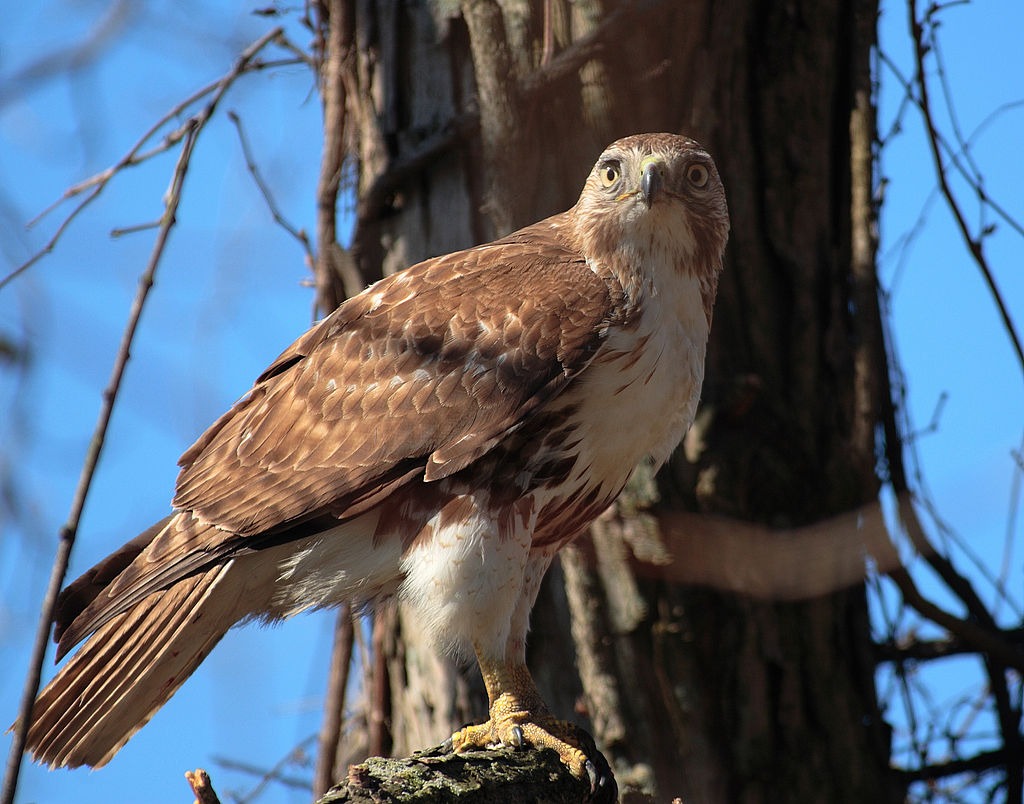
The Red-tailed Hawk is our most common buteo in Texas and North America. Their range is throughout North America except the Arctic. Most birds are permanent residents of the area they are born, but the most northern birds will migrate south in the winter. In Texas, you will see more Red-tailed Hawks in winter due to this migration. In the summer only the permanent resident birds remain.
Description: There are many plumages of this buteo. They can range from leukistic (known as albinos or white) to almost black (known as a Harlan’s morph). The common plumage is a light brown chest with a darker “belly band” (that can be very different from bird to bird), Dark brown wings and a rusty red tail. Immature birds look very different their first year. Their tail has dark bands of brown, black and white and is actually longer than an adult. They are more black and white versus the brown wash overall of the adult. Iris colors change from a light color to a dark brown within two years.
Habitat: Found in most areas. Prefer sitting on high perches overlooking open fields. In cities, commonly found on telephone or light poles over median strips. Will be seen soaring over fields.
Flight: Slow wing beats with intermittent soaring. Will do lazy circles when soaring on thermals. Will hover or “kite” (flap wings while remaining in one place) in the wind.
Vocalization: Known for its raspy long scream that falls in pitch.
Food: Mainly mammals; mice, rats, squirrels and rabbits. Occasionally will go after birds and snakes.
Nesting: Found in tall trees. Made of sticks. They will use the same nest for many years. They usually lay 2-3 eggs that are incubated for about 28 days. Young fledge in about 7 weeks but will hang around parents for quite a while afterward.
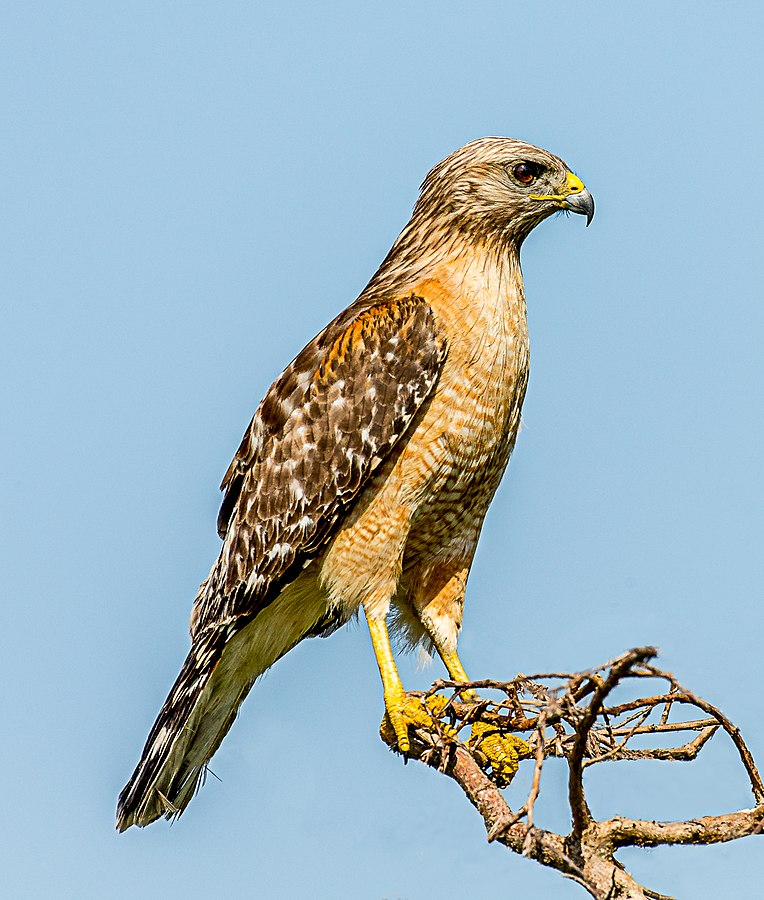
The Red-shouldered Hawk is a common buteo in East Texas and eastern North America.
Birds are permanent residents of the area they are born, but the most northern birds will migrate south in the winter.
Length: 17”
Wingspan: 38 – 42”
Weight: 1.4 – 2 lbs
Plumage: Adults have dark rusty chests with light horizontal barring. Wings and tail are black with white horizontal barring. The red shoulders are not easily seen at a distance. Iris darkens with age from light to dark brown. Immature birds have brown vertical stripes on their chest and the tail is brown with light brown bands.
Habitat: Found in wooded areas near streams and rivers.
Flight: Strong wing beats with intermittent gliding. Flies through woods with ease. Perches in trees.
Vocalization: Loud “keeyuur-keeyuur”, usually 3-4 times, that drops in pitch. Very vocal species especially in spring when courting or protecting territory.
Food: Small mammals, amphibians, snakes, birds
Nesting: Found in the crotch of tall trees. Made of sticks. They may use the same nest, but more often will build a new one. They usually lay 2-3 eggs that are incubated for about 25 days. Young fledge in about 6 weeks.
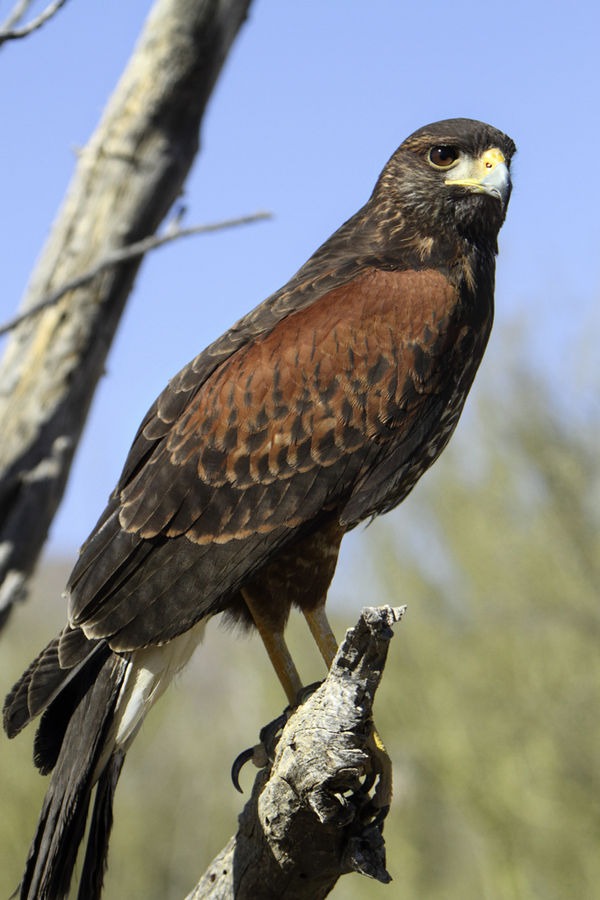
The Broad-winged Hawk is a migrant in east Texas and eastern North America. Some take up residence in Texas during the summer, especially east Texas. These birds migrate to Central and South America, approximately 4,500 miles, each fall. They can be seen flying in “kettles” (large flocks soaring together).
Length: 20”
Wingspan: 43”
Weight: 2 lbs
Plumage: Adults have a dark brown body and head, and rusty wings. The base of the tail is white with a wide black stripe and white at the tip. Immature birds are similar but have a streaked chest.
Habitat: Found in open, arid grassland areas.
Flight: Typical flight of raptors between flapping and soaring.
Vocalization: A loud keerh.
Food: Mammals.
Nesting: Found in small trees usually 5 – 20 feet up.. Made of twigs. They usually lay 2-4 eggs that are incubated for about 31 days. Young are out of the nest in about 36 days but don’t fly for another week or so.
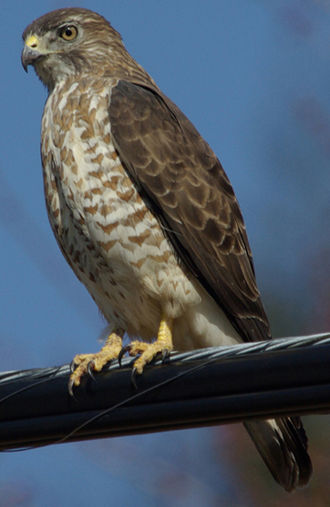
The Broad-winged Hawk is a migrant in east Texas and eastern North America. Some take up residence in Texas during the summer, especially east Texas. These birds migrate to Central and South America, approximately 4,500 miles, each fall. They can be seen flying in “kettles” (large flocks soaring together).
Length: 15” – 17”
Wingspan: 35”
Weight: 14oz
Plumage: Adults have a dark face and white throat, The chest has brown-red barring. In flight, the trailing edges of the wings are very dark. The tail is dark with one wide white band in the middle and a thinner white band at the tip. Immature birds are similar but the barring is brown on the chest and the tail has uniform brown and black stripes.
Habitat: Found in forests.
Flight: Fairly rapid wing-beats.
Vocalization: A high, thin whistle, ‘teee-eeeeeee’ on one pitch.
Food: Small mammals and insects found in wooded areas.
Nesting: Found in trees usually 15 – 20 feet up. Made of twigs. They usually lay 2-3 eggs that are incubated for about 28 days. Young are out of the nest in about 30 days but get help from adults for another 30 days.
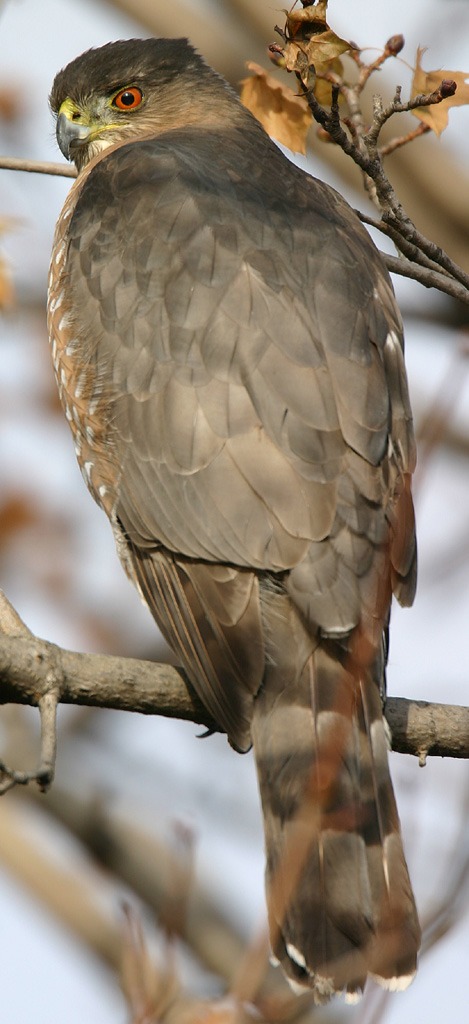
The Cooper’s Hawk is a year-round resident in most of Texas and the United States. It is usually found in wooded areas. But with development, they have found a new niche, the backyard. With the decrease of habitat and increase in bird-feeding by humans, the Cooper’s Hawk has adapted well.
Length: 16”
Wingspan: 29-31”
Weight: 1 lb
Plumage: Adults have a dark head, back and wings. The chest has rusty red horizontal barring. The tail is long and alternates dark brown and light gray horizontal stripes. The tip of the tail is white and rounded. Iris changes color with age from light yellow to a dark raspberry red. Immature looks very different. Brown head, back and wings. Chest has vertical brown stripes. Tail similar to adult.
Habitat: Found in woodlands but has adapted to suburban backyards.
Flight: A fast-moving bird with strong wing beats. Normal flight pattern of accipiters is flap-flap-glide, flap-flap-glide. When chasing prey it will dive into bushes or trees without slowing down. Can be seen walking around bushes when prey is attempting to hide.
Vocalization: A loud, fast kek-kek-kek, especially when protecting the nest.
Food: Small birds and mammals.
Nesting: Found in crotch of trees. Made new each year of sticks. They usually lay 4 eggs that are incubated for about 36 days. Young fledge in about 5 weeks.
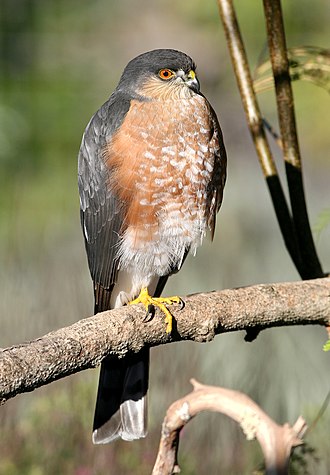
The Sharp-shinned Hawk is becoming a year-round resident in parts of Texas and is common throughout the United States. It is usually found in wooded areas. They have not adapted as well to the destruction of habitat as the Cooper’s Hawk. This accipiter is very similar to the Cooper’s Hawk in plumage and the two can be confused. Sharp-shinned Hawks have smaller head size compared to their body, whereas the Cooper’s Hawk has a large, square head. Legs on Sharp-shinned Hawks are very thin.
Length: 11”
Wingspan: 22”
Weight: 4 oz.
Plumage: Similar to Cooper’s Hawk. Adults have a dark head, back and wings. The chest has rusty red horizontal barring. The tail is long and alternates dark brown and light gray horizontal stripes. The tip of the tail is white and square compared to the rounded tail of the Cooper’s Hawk. Iris changes color with age from light yellow to a dark raspberry red. Immature looks very different. Brown head, back and wings. Chest has vertical brown stripes. Tail similar to adult.
Habitat: Found in woodlands.
Flight: A fast-moving bird with strong wing beats. Normal flight pattern of accipiters is flap-flap-glide, flap-flap-glide. When chasing prey it will dive into bushes or trees without slowing down. In flight, the wings are as far forward as the head.
Vocalization: A loud, fast kik-kik-kik, especially when protecting the nest.
Food: Small birds and mammals, insects, frogs and lizards.
Nesting: Found in trees. Made new each year of sticks. They usually lay 4 eggs that are incubated for about 35 days. Young fledge in about 3-4 weeks.
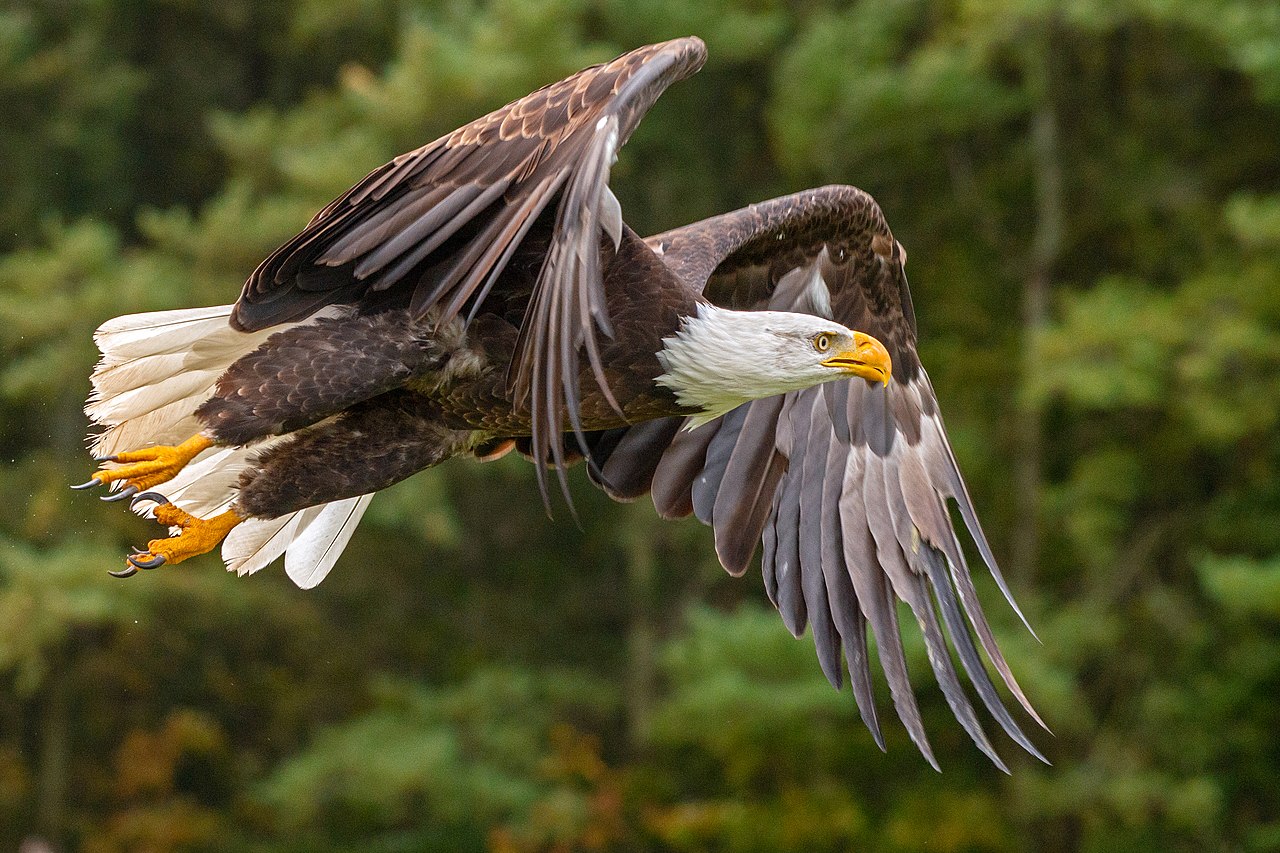
The Bald Eagle is becoming more common in north Texas, especially in winter. It is usually found at the larger area lakes. Nesting has increased as well.
Length: 32”
Wingspan: 80”
Weight: males: 9 –10 lbs, females: 10 – 13 lbs
Description: Very large, distinct bird. Adults have white heads and tails while the rest of the body is dark brown. They have a yellow beak. It takes four years to acquire adult plumage. Birds in their first three years go through a number of plumage changes beginning as all brown and they become more white and brown mottled overall in years two and three.
Habitat: Found near large bodies of water.
Flight: Slow, shallow wing beats. Soars with wings almost flat.
Vocalization: A chirping noise, not very strong.
Food: Mainly fish and waterfowl. Will scavenge these foods if possible.
Nesting: Found in large trees, usually next to water. Site will be re-used every year with additional sticks being added. Nests are usually 6 ft. wide and 2 feet deep, but old nest have been measured up to 8 feet wide and 12 feet deep. Breed in winter. Usually 2 eggs that hatch in about 43 days. Leaves nest in 11 weeks but remains nearby for many weeks.
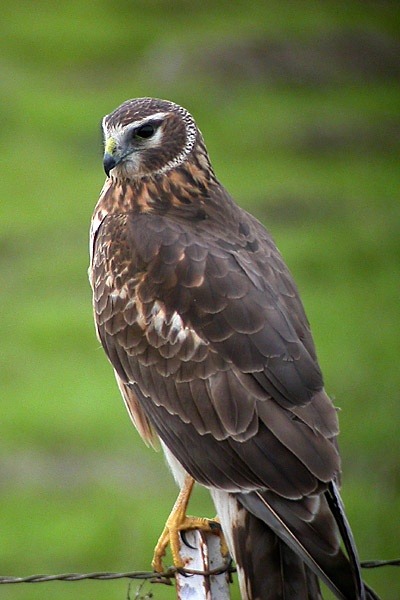
The Northern Harrier is a winter visitor to north Texas.
Length: 18”
Wingspan: 43”
Weight: 1 lb
Plumage: White rump patch always obvious, otherwise the adult males and females look quite different. The males are almost white on the chest and underside of wings with black tips. The back and topside of wings are gray. Tail is gray and black striped. The females are mostly mottled brown all over. Harriers have an owl-like facial disc
Habitat: Found in open fields and marshes.
Flight: Very erratic flight, known as ‘coursing’. A combination of flapping and gliding with no consistency. Again, the white rump patch will be obvious.
Vocalization: Female and young have high-pitched whistle. Males have fast call ‘kekekekeke’.
Food: Small birds and rodents.
Nesting: On the ground, usually around tall vegetation. There are 4 – 6 eggs that hatch in about 35 days. Young fledge in about 40 days.
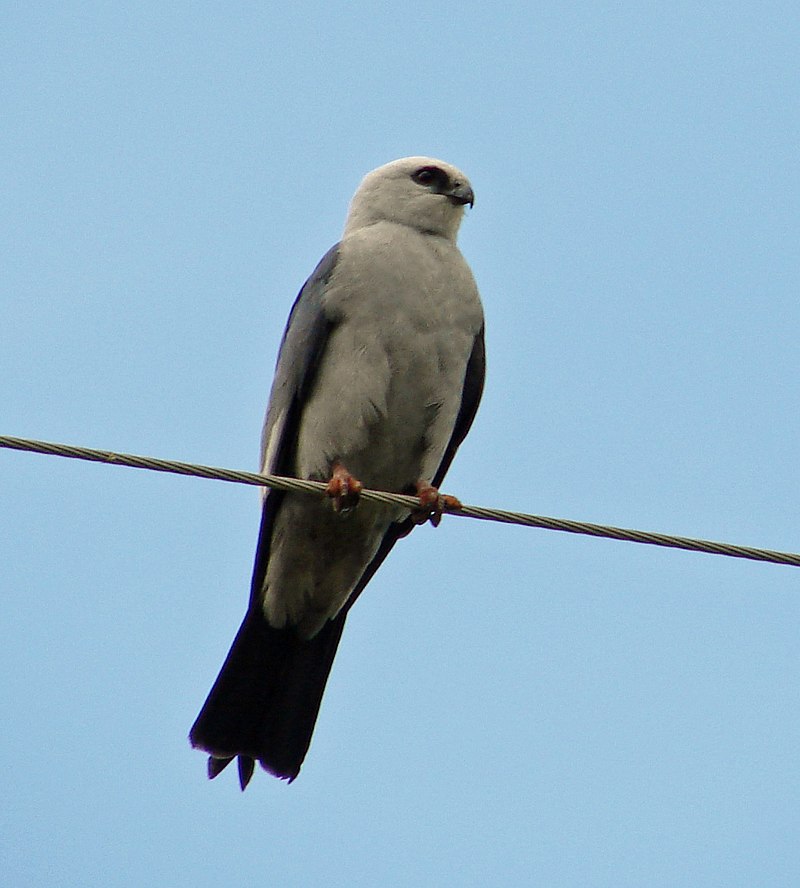
The Mississippi Kite is a summer resident in parts of north Texas and southeast states. They have a very definite line where they nest. Very rarely do you find them in Dallas, but in Sherman and north, they are very common. These birds migrate to Central America and south in the winter. They begin migration early, August to September, and have been known to abandon young in favor of migration.
Length: 14”
Wingspan: 30”
Weight: 10 – 12 oz.
Plumage: Adults are almost all gray with a black tail and a dark red eye. Immature birds have rusty stripes on their chest, gray wings with white spots and a black tail.
Habitat: Found in grasslands with woods nearby.
Flight: Will kite over fields looking for prey.
Vocalization: A high-pitched Pe-teeeeew, the second part is a descending whistle.
Food: Insects caught and eaten while flying.
Nesting: Found in trees next to fields. Made of twigs. They usually lay 2 eggs that are incubated for about 30 days. Young fledge in about 5 weeks. Young are fed on the wing.
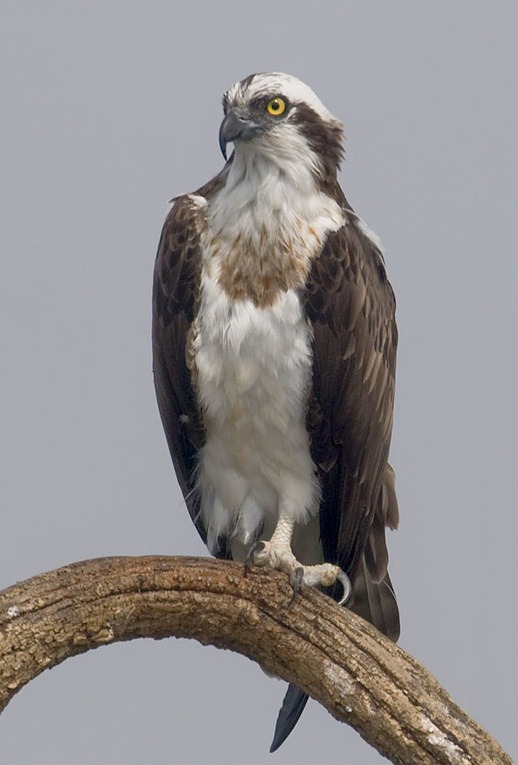
The Osprey is a fairly common raptor but is only found on area lakes.
Length: 24”
Wingspan: 64”
Weight: 3.5 lbs
Description: Distinctive bird. Back and wings are black, the chest is white and the tail is mostly black with some light gray stripes. Head is mostly white with a black stripe through the eye. When in flight, has a distinct color to wings.
Habitat: Found near large bodies of water.
Flight: Slow, shallow wing beats. Long, narrow wings. Will hover over water and dive talons-first to catch fish.
Vocalization: A high-pitched call, teew, teew, teew.
Food: Fish.
Nesting: Found in tops of trees or rocky outcrops looking over water, site will be re-used every year with additional sticks being added. Usually 3 eggs that hatch in about 33 days. Leaves nest in 6 – 7 weeks but remains nearby for many weeks.
Notes: Sometimes confused with Bald Eagles, but much smaller and has black tail and black eye-stripe whereas the eagle’s tail and head are all white when adults. When Osprey’s are flying with a fish in their talons, they always hold the head of the fish forward, this is thought to make it much more aerodynamic in flight. The only raptor that can be almost completely submerged in water, when it catches a fish, and take off again.
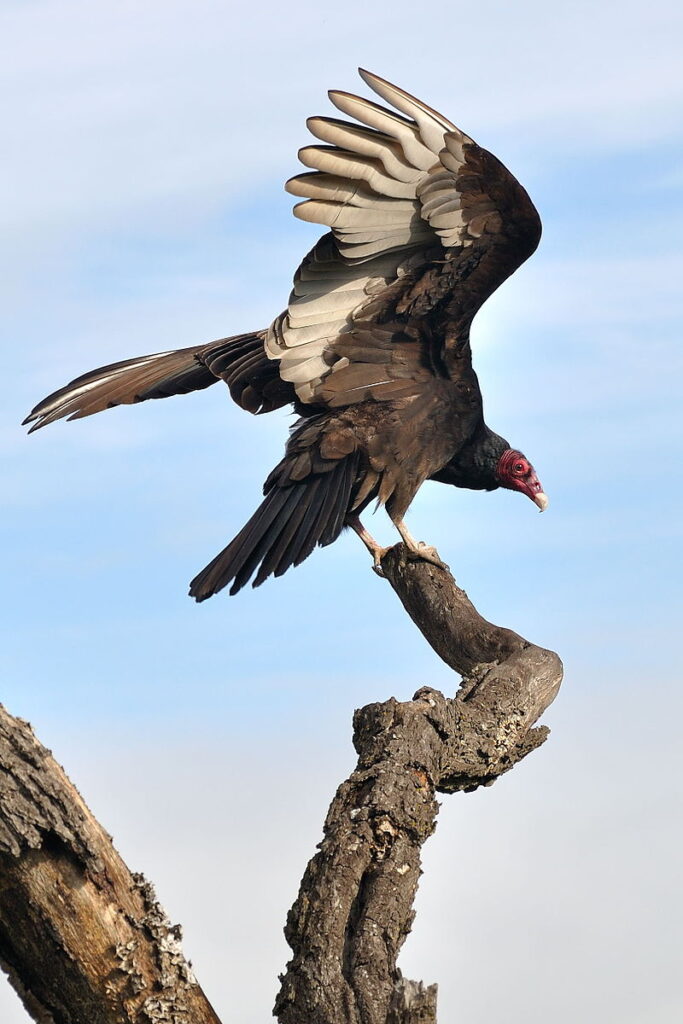
The Turkey Vulture is a year-round resident in Texas and is common throughout the United States. They are carrion-feeders and can be found soaring and roosting in groups. Turkey Vultures can be distinguished from Black Vultures by shape and flight. Turkey Vultures soar with a dihedral wing shape (imagine a V-shape) and they rock back and forth. Tail is long. Black Vultures soar with wings almost flat and rarely rock back and forth. They have very stubby tails.
Length: 25”
Wingspan: 68”
Weight: 4 lbs
Plumage: Black on back, tail and wings. Red head and pale legs. From underneath in flight, Wing tips and trailing feathers are gray compared to rest of body. Babies are white down with black head.
Habitat: Found mainly in open areas but can be seen anywhere.
Flight: Often soaring, rocking back and forth. Has dihedral (V-shape) to wings. When roosting, will open its wings to dry them off before taking flight.
Vocalization: Has no ‘vocal chords’. Only hisses.
Food: Carrion of any kind.
Nesting: Found on the ground or in unused buildings. No nests are made, just a flat surface that may be scraped out a little. They usually lay 2 eggs that are incubated for about 38 days. Young fledge in about 11 weeks. If babies are found, leave them alone, they are supposed to be on the ground. Vultures are extremely susceptible to ‘imprinting’. If humans attempt to raise them, they will become attached to humans and can’t be released into the wild. Attempting to raise baby birds is against the law unless given state and federal permits.
Defense: Vultures will ‘throw up’ their food if they feel threatened.
Note: Turkey Vultures find food by smell. They can smell carrion over a mile away. Black Vultures will follow them because they do not have a good sense of smell.
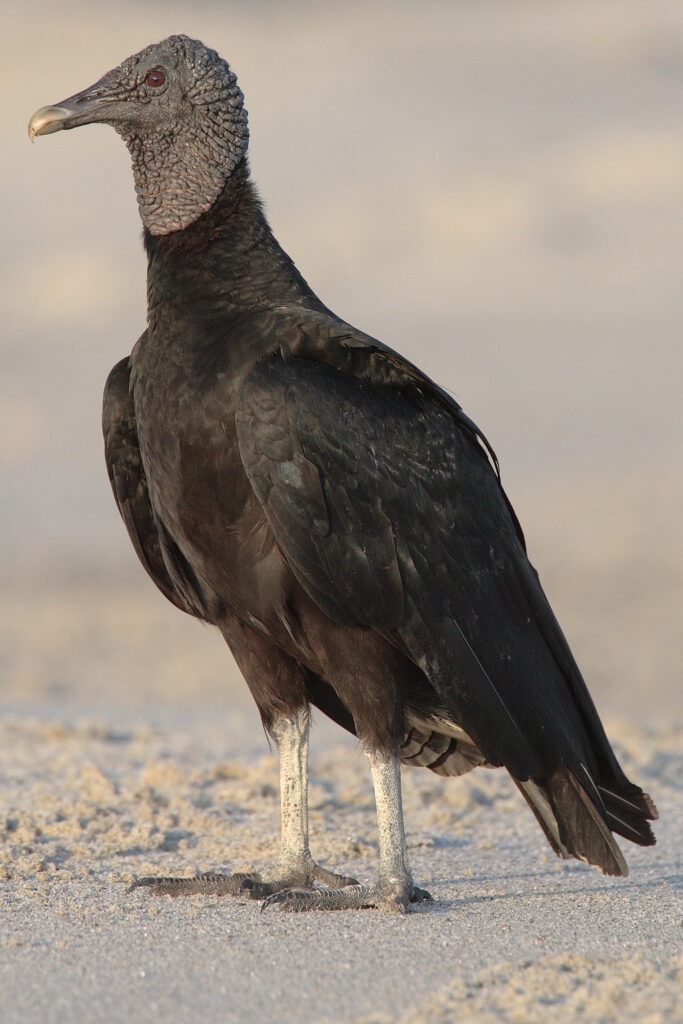
The Black Vulture is a year-round resident in Texas and is common in the southeast United States. They are carrion-feeders and can be found soaring and roosting in groups. Black Vultures can be distinguished from Turkey Vultures by shape and flight. Black Vultures soar with wings almost flat and rarely rock back and forth. They have very stubby tails. Turkey Vultures soar with a dihedral wing shape (imagine a V-shape) and they rock back and forth. Tail is long.
Length: 25”
Wingspan: 60”
Weight: 4 lbs
Plumage: Black on back, tail, wings and head. Legs are dark gray. From underneath in flight, wing tips are gray compared to rest of body. Babies have tan down with black head.
Habitat: Found mainly in open areas but can be seen anywhere.
Flight: Often soaring with almost flat wings. When roosting, will open wings to dry off them off before taking flight.
Vocalization: Has no ‘vocal chords’. Only hisses.
Food: Carrion of any kind.
Nesting: Found on the ground, unused buildings or ledges of cliffs. No nests are made, just a flat surface that may be scraped out a little. They usually lay 2 eggs that are incubated for about 33 days. Young fledge in about 8 weeks but depend on parents for another 3 weeks. If babies are found, leave them alone, they are supposed to be on the ground. Vultures are extremely susceptible to ‘imprinting’. If humans attempt to raise them, they will become attached to humans and can’t be released into the wild. Attempting to raise baby birds is against the law unless given state and federal permits.
Defense: Vultures will ‘throw up’ their food if they feel threatened.
Note: Black Vultures do not have a good sense of smell and will follow Turkey Vultures to find food.
